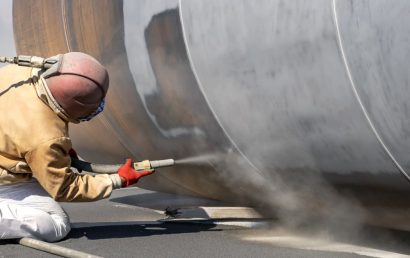Fabricators Need to Embrace Thermal Spray Today
Thermal spray is an essential part of the fabricating industry and is used in various applications – even though many are still not familiar with it. When it comes to contemporary fabrication processes, thermal spray is quickly gaining recognition. Possibly the most common application of thermal spray is zinc coating.
Why Zinc Coating?
On school grounds and at overpasses are two places where zinc coatings can frequently be seen. Have you ever noticed fencing leaving behind a rusty trail? If zinc coating had been used in the welding between the galvanized mounting plates and the galvanized fence post, this rusting would likely never have taken place. It is a neglected step by the fabricator. Rusty fencing is, of course, only one tiny example of how the zinc coating can be utilized – but you get the idea.
Defining Thermal Spray
Thermal spray provides a barrier against radiation, light, erosion, abrasion, extreme temperatures, and chemicals. But, it can also be used on stealth aircraft to form a protective barrier against radar. Additionally, it can stop differential thermal expansion related stress between the body and the surface of an object. It can be used to modify a surface’s friction factor, in clearance control, rebuilding, and in repairing.
In products such as gas turbines, prostheses, and other advanced fabricated products, thermal spray plays an essential role. These items demand high performance and thermal spray guarantees that precise level of operation.
The process of thermal spray incorporates thermodynamic properties in a wide range. Whatever material is being used for the coating process is first heated and then sprayed on a part. The part being coated is referred to as the substrate. Either a plasma process or an electric arc process is the next step in the equation and referred to as the combustion process. It is what is responsible for the heat required. The material being used for coating purposes can be introduced either as a wire or in powder form.
New Thermal Spray Opportunities for Fabricators
Of great interest to fabricators, these three applications of thermal spray are the newest in the industry:
3-D printing – Fabricators are very excited about this area. Let’s face it, 3-D printing, in and of itself, is extremely exciting. But the 3-D printing systems that are most popular are challenging in that they are confined to using material that is thermal/plastic. Thermal spray changes all that. A printed part can now be coated with a metallic material. (The coating material must, of course, go along with the end use.) Problem solved.
Erosion control – Hydropower plants are being installed everywhere thanks to the demand for fresh energy sources that are environmentally friendly. A problem arises, however, because of the abrasive nature of water. Thermal spray introduces good news because now the turbines used to provide energy from hydropower plants can be protected. In critical areas, an HVOF applied tungsten carbide is used.
Plating – Where repairs are involved, old-school hard chrome plating is time consuming and has environmental problems. But HVOS coatings are far superior to hard chrome plating for their corrosion resistance, wear resistance, for being environmentally safer, and less time-consuming. Airlines, commercial groups, and government groups are now all using HVOF coatings extensively.
When it comes to thermal spray, A&A Coatings is a leader in the industry. For over 70 years wehave been providing various protective coating spray applications using numerous materials. In doing so, we are responsible for also protecting the bottom line of many companies by lowering maintenance costs and lessening down times due to machinery breakdown.
Contact us today to find out why applying protective coatings through thermal spray can be important to your company.



